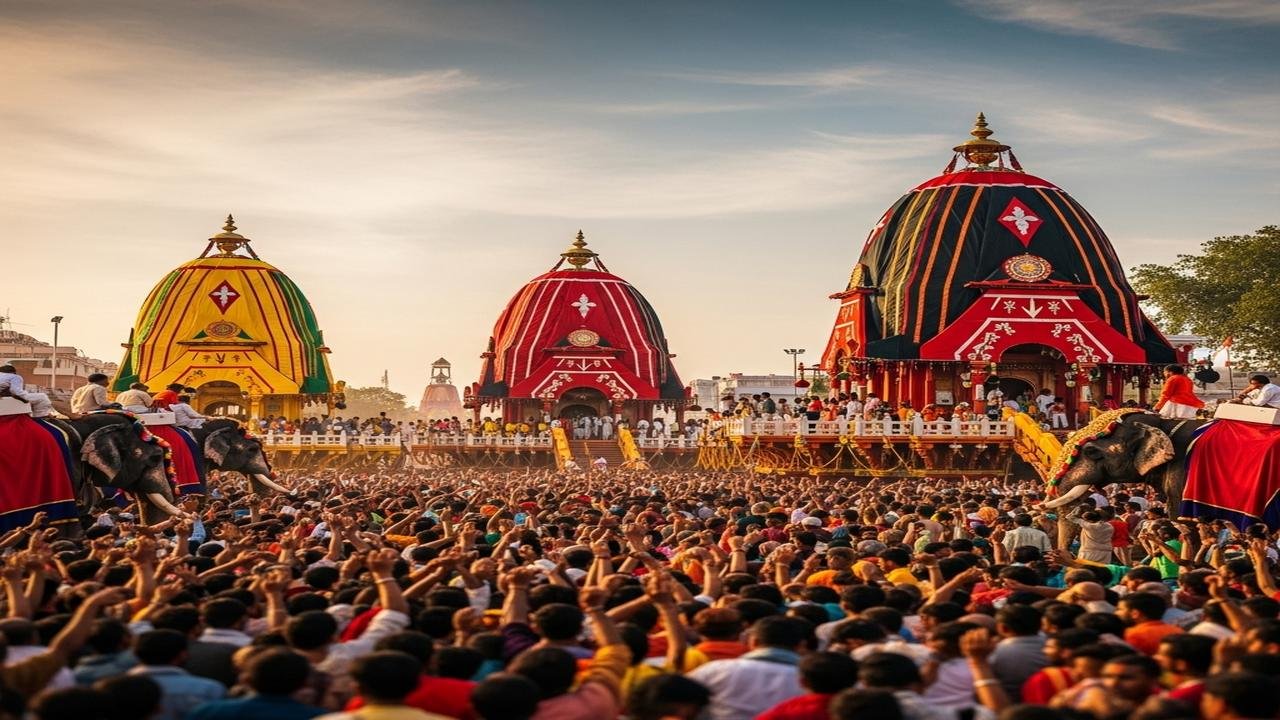Jagannath Rath Yatra: Why Puri’s Three Chariots Mystify

Opening the chariot door: why Jagannath Rath Yatra still feels mysterious
The Rath Yatra of Jagannath — literally “Lord of the World” — is among India’s most visible religious events: three enormous, brightly painted chariots roll down Puri’s Bada Danda each year and draw millions of people. Yet the festival remains a fertile site of questions rather than settled answers. Its visual drama is unmistakable, but its origins, layered meanings and many local practices resist any single explanation. This piece outlines what happens, what scholars and devotees say it means, and why the festival keeps generating debate and wonder.
What happens during the festival
The Rath Yatra normally takes place in the Hindu month of Ashadha (June–July), on the **Shukla Dwitiya** (second day of the bright half). The broad sequence at Puri is familiar to many:
- Snana Yatra — the bathing festival before the chariot procession; after this the deities are said to fall ill and enter an anavasara (period of inaccessibility) in which public darshan is suspended.
- Pahandi — the ceremonial removal of the deities from the inner sanctum and their procession to the chariots; the images are carried in a ritualised fashion and wrapped before placement on the raths.
- Rath Yatra proper — Jagannath, his brother Balabhadra and sister Subhadra are placed on three separate chariots and pulled by devotees along the Bada Danda to the Gundicha Temple, a distance of roughly three kilometres.
- Gundicha stay and Hera Panchami — the deities remain at Gundicha Temple for several days; on the fifth day the ritual Hera Panchami (where the goddess Lakshmi is said to inspect Jagannath’s absence) is observed.
- Bahuda Yatra and Niladri Bije — after their stay the deities return in the Bahuda (return) journey; Niladri Bije marks the final re-entry into the main sanctum.
Important ceremonial features include the chariots themselves (made anew each year by traditional artisan families), the public pulling of ropes (open to all faiths and castes), and the role of temple servitors (sevayats) who perform sensitive, sometimes secret rites. The Gajapati Maharaja of Puri still performs a visible ritual — the Chhera Pahanra — where he sweeps the chariot platform with a golden broom, symbolising the king’s service to the deity.
The icons, materials and renewal
The Jagannath images are wooden and stylised — not the anthropomorphic, carved stone images familiar in many other temples. The wooden log (often called daru) is central to the tradition. Periodically, in a ritual called Nabakalebara (“new body”), the old idols are replaced after secretive searches for suitable sacred trees, and new images are carved and consecrated. Nabakalebara does not follow a strict uniform interval; it occurs when the lunar and calendrical criteria align, typically every 12–19 years.
Interpretations: many layers, few certainties
The festival invites multiple, often overlapping readings:
- Vaiṣṇava devotional frame: For many Vaiṣṇavas, Jagannath is a form of Krishna or Vishnu, and the chariot is a theophany — God’s accessible pilgrimage among people. Commentators emphasise grace, devotion and public darshan.
- Royal and political symbols: The ceremony stages a king-servant relationship (note the Gajapati’s sweeping), and chariot imagery recalls ancient rulership and cosmic sovereignty — the lord who moves among his subjects.
- Tribal and local continuities: Some historians and anthropologists highlight non-Vedic, tribal elements — the wooden image, certain ritual songs and the crowd-centred pull of the rath — suggesting assimilation of older local cults into a broader Brahmanical framework.
- Sociological lens: The festival’s public inclusion (anyone can pull the rope) underscores civic and ecological aspects of ritual life: it is a social performance of belonging as much as an act of devotion.
Scholars accept that these are not mutually exclusive: the Rath Yatra is a palimpsest where Vedic, tribal, royal and popular layers coexist. Devotees may emphasise one reading while historians stress another. The ritual’s power often comes from this multivalence rather than a single “original meaning.”
Reasons for the mystery
Several factors make the festival resistant to straightforward explanation:
- Fragmentary historical records: Early epigraphic evidence is limited; many origin accounts are medieval or mythic, like the legend of King Indradyumna, which mix history and theology.
- Living secrecy: Certain rites, kitchen protocols and the Nabakalebara tree-search are conducted by restricted groups and kept intentionally undisclosed to preserve sanctity.
- Continuous adaptation: The festival changes with time — new crowd-management needs, media, politics and conservation concerns alter how rituals are staged and perceived.
Contemporary questions and concerns
Today Rath Yatra raises practical and ethical debates as much as religious ones: how to reconcile mass devotion with safety and conservation, how to procure huge amounts of timber for chariots responsibly, and how temple governance balances tradition with transparency. The festival is also a major cultural export — a diasporic Jagannath Ratha Yatra is held in many cities outside India — raising questions about translation versus preservation of ritual detail.
Practical note: many devotees fast or undertake rigorous observances associated with the festival. If you have health concerns, consult a medical professional before fasting or taking part in strenuous rituals.
Conclusion: an invitation rather than an answer
Rath Yatra resists a single interpretation because it is, effectively, many festivals in one. It is textual and oral, tribal and Brahmanical, royal and popular, local and global. That complexity produces mystery — not because evidence is absent, but because the festival’s vitality comes from its capacity to hold divergent meanings at once. Whether read as cosmic drama, social theatre or heartfelt devotion, Jagannath’s chariot continues to invite millions to step into a moving, communal encounter with the sacred.
